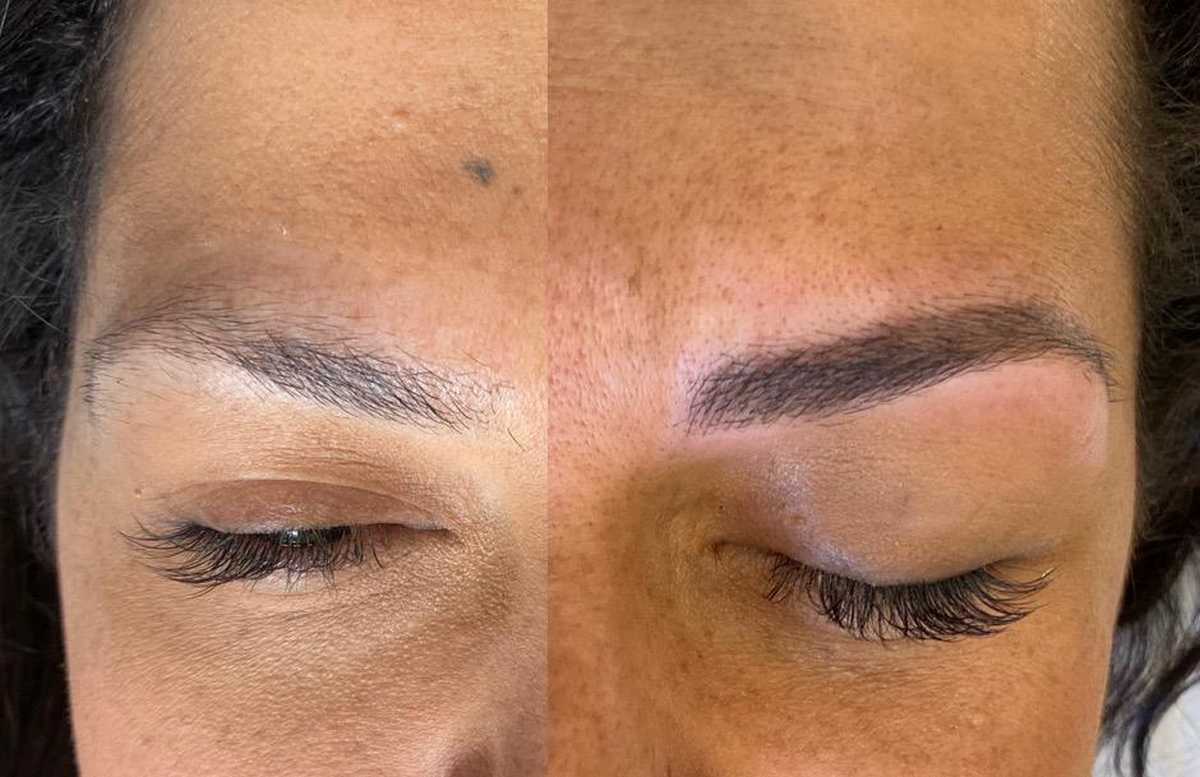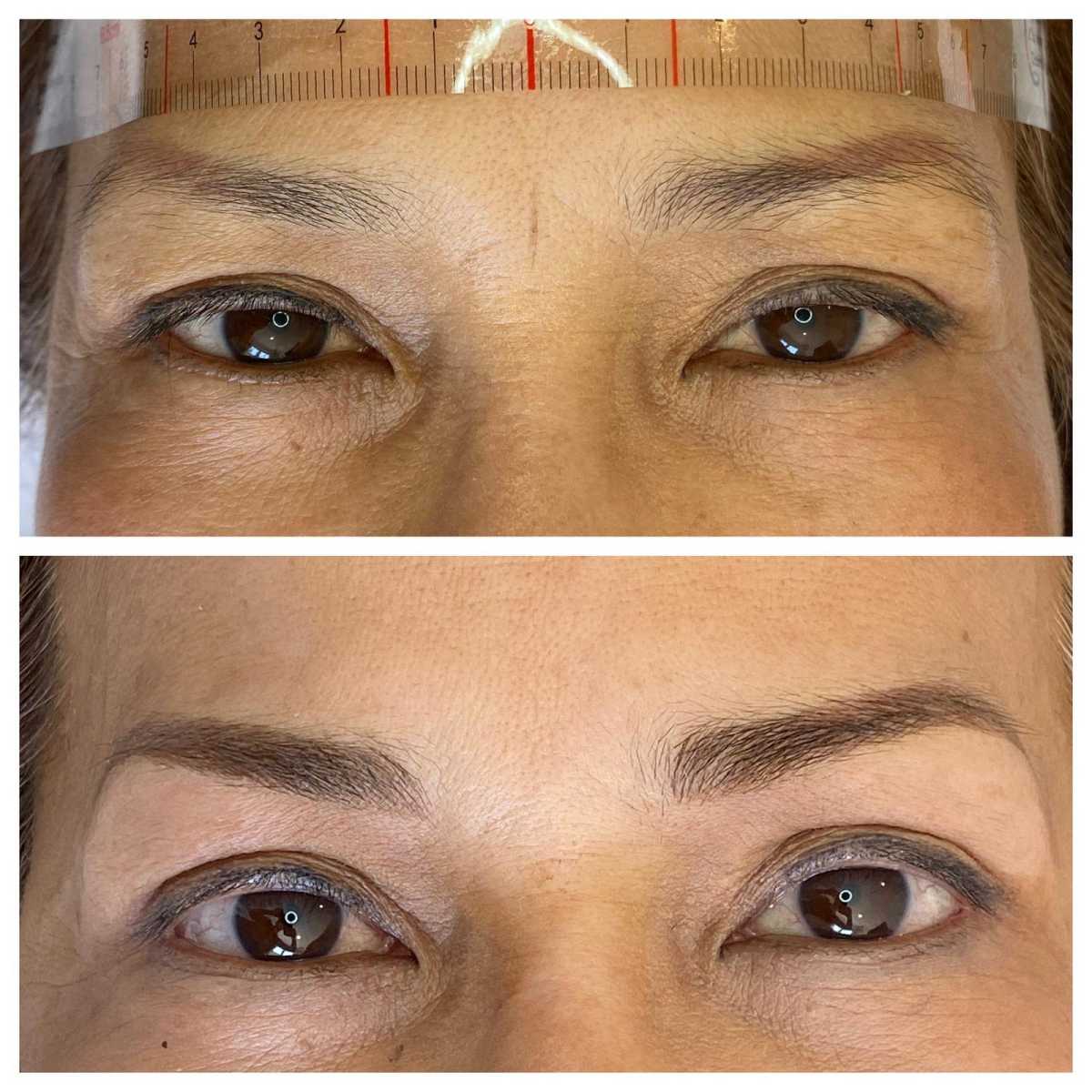Microblading is a popular semi-permanent cosmetic procedure that creates natural-looking eyebrows. However, one of the main concerns people have is whether or not their microblading will fade and what to do if it doesn’t fade as expected.
This guide will walk you through the key aspects of microblading fading, its causes, and how to address any issues that may arise.
Let’s get straight to the point
Microblading is a semi-permanent cosmetic procedure that typically lasts 12 to 24 months, but various factors influence how it fades. Pigment quality, depth of application, and the presence of scar tissue can affect the fading process, sometimes causing microblading to last longer than expected.
If microblading doesn’t fade naturally, professional methods like laser or salt removal can help, as can at-home remedies like exfoliation. To maintain microblading results, avoid water, sweat, and sun exposure.
Some people may want microblading to fade faster due to unsatisfactory results or colour changes over time. Misconceptions include the belief that microblading never fades or that fading indicates poor quality, both of which are incorrect.
Does Microblading Fade?
Yes, microblading is designed to fade over time. The pigment typically lasts between 12 to 24 months before gradually fading away.
If left untouched, the results should fade naturally as the body breaks down the pigment. However, if your microblading does not fade as expected, there are ways to speed up the process or correct any issues.
Reasons Why Microblading May Not Fade
There are several factors that could cause microblading to not fade as anticipated:
Quality of Pigment
The type of pigment used plays a significant role in how long the microblading lasts. If the pigment contains ingredients that your body struggles to break down, it may take longer for the colour to fade.
Organic pigments tend to fade more quickly compared to non-organic pigments.
Depth of Pigment
Microblading pigment should be placed in the middle layer of the skin (the dermis). If the artist inserts the pigment too deeply, it may take longer for your body to break it down, causing it to last longer than desired.
Presence of Scar Tissue
Scar tissue on or near your eyebrows can prevent the pigment from fading naturally. Since scar tissue does not exfoliate like healthy skin, the pigment may remain trapped in the tissue for an extended period.
Fixes for Microblading That Doesn’t Fade
If your microblading is not fading as expected, there are professional and at-home methods to address the issue.
Professional Removal Methods
There are two main techniques to professionally remove microblading:
- Laser Removal: Laser treatments use light to break down the pigment in the skin, allowing the body to naturally remove it. Multiple sessions may be required for complete removal.
- Salt Removal: This involves applying a saline solution to the brows to draw the pigment out of the skin. Fewer sessions are generally needed than with laser removal.
Correction Techniques
If your microblading has faded unevenly or left a shadow, a touch-up or correction procedure can help:
- Redoing Strokes: If the remaining pigment is light enough, new strokes can be added to refresh the look.
- Shading: For darker remnants, shading can help blend the original and new pigments.
How to Prevent Microblading From Fading Too Quickly?
If you’re happy with your microblading results and want to maintain them for as long as possible, here are some tips:
Avoid Water and Sweat
For the first week after your procedure, avoid getting your brows wet and refrain from heavy sweating. This will help preserve the pigment and ensure your brows heal properly.
Use Sunscreen
Sun exposure can cause the pigment to fade prematurely. Applying sunscreen to your brows when going outside can help protect the colour.
Be Careful with Skincare Products
Avoid using products with harsh ingredients (like retinol or alpha hydroxy acids) around your brows, as these can cause the pigment to fade faster.
Why Might You Want Microblading to Fade Faster?
There are several reasons why you might want to speed up the fading process:
- Unsatisfactory results: The shape or colour of your brows may not be what you expected, and you may want them to fade sooner.
- Colour change: Over time, some pigments may change colour, turning orange or grey. This can be due to low-quality products or improper aftercare.
- Tired of the look: You might simply want to return to your natural brows or try a different style.
How Long Does Microblading Last?
Microblading typically lasts between 12 to 24 months. However, the exact duration depends on several factors, such as skin type, pigment quality, and aftercare.
Factors That Affect Microblading Longevity
|
Factor |
Effect on Longevity |
|
Skin Type |
Oily skin causes faster fading. |
|
Aftercare |
Proper care extends the life of the pigment. |
|
Pigment Quality |
Higher quality pigments last longer. |
|
Sun Exposure |
UV rays accelerate fading. |
Common Misconceptions About Microblading Fading
There are a few myths surrounding microblading fading that can cause confusion. Here are some common ones:
- Myth: Microblading never fades.
- Fact: While microblading can take longer to fade for some individuals, it will eventually break down and disappear.
- Myth: Fading means poor quality.
- Fact: Fading is a normal part of the process, but uneven or premature fading could indicate improper aftercare or low-quality pigments.
Conclusion
Microblading is a great option for achieving natural-looking brows with minimal maintenance, but the results are not permanent. Fading typically occurs over 12 to 24 months, but factors like pigment quality, aftercare, and skin type can affect how long the results last.
If your microblading doesn’t fade as expected, professional removal options are available, as well as at-home methods to lighten the pigment. However, it’s important to be cautious and consult a professional to avoid any risks of infection or uneven results.
With proper care, your microblading can give you the beautiful, long-lasting brows you desire.
FAQs About Microblading Fading
Why Does My Microblading Look Fade?
Fading may occur if the brow gets too wet after microblading, if improper ointment is used, or if the face is exposed to direct sunlight. Most patients choose dry healing since it is less time-consuming and has a cleaner appearance than wet healing.
Does Microblading Fade And Then Come Back?
It would be best if you were patient since the microblading will disappear after the scabs fall off, which is quite natural. However, the colour will eventually return as time passes and the scabs fall off on their own.
During this stage of the process, it is essential to continue according to the aftercare guidelines. After six weeks, you will be able to get an evaluation of your microbladed brows.
Why Is My Microblading Not Showing Up?
It’s a Normal Part of the Healing Process. The pigment may appear faint to certain people, almost as if the microblading didn’t take.
However, this stage, known as the ghosting phase, is a natural and expected component of the rehabilitation process. Therefore, it is anticipated that the pigment will return.
Does Microblading Ever Fade Completely?
The microblading process is intended to be a semi-permanent solution, and it is perfectly safe when performed by a trained professional. This indicates that the tattoo is of the semi-permanent variety and is designed to disappear gradually over time. After the initial treatment, microblading should be gone within two years if no maintenance procedures are performed on it.
How Do You Know If Microblading Didn’t Work?
If it has been more than two weeks and your pigment has disappeared, then this is most certainly NOT normal and is related to some other problem. In this particular instance, it is possible that your artist did not go as far as they could have. Your artist needs to go into the dermal-epidermal junction to produce long-lasting effects.



